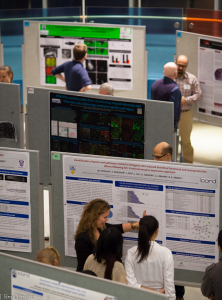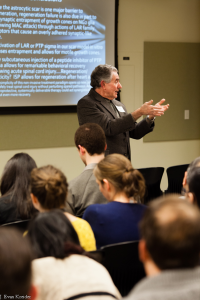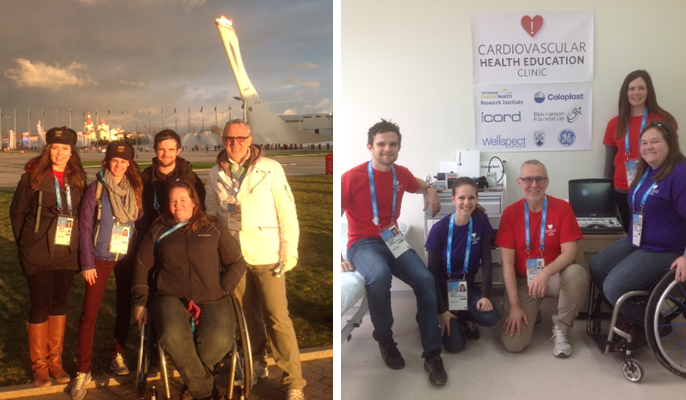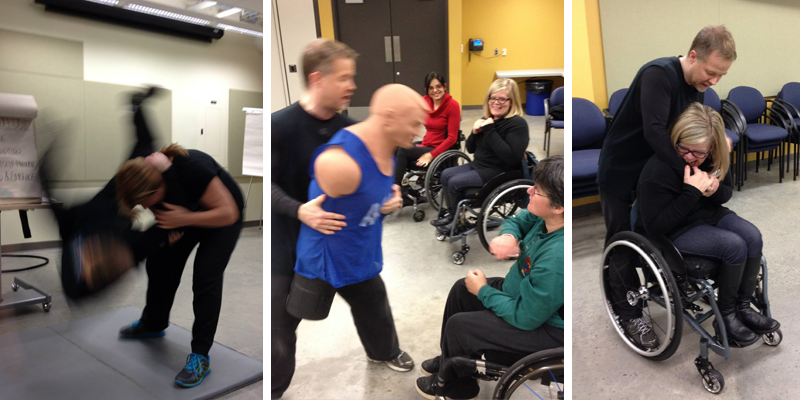Welcome to the third issue of the ICORDian community newsletter. Included in this issue: we report on our Annual Research Meeting, tell you how an ICORD researcher is connected to some ground-breaking SCI research coming out of Kentucky, give you the low-down on this year’s Spinal Chord gala, and tell you about some new ICORD studies you can take part in. We’ll also introduce you to a very long list of very talented people.
Contents
- Annual Research Meeting report
- Back from Sochi
- Community Research Meeting
- Research: our Kentucky connection
- Spinal Chord Gala preview
- Proprioception and other current research studies
- Self-defense class: a big hit!
- Staff award winners
- Trainee poster awards
- Join Team Walk ‘n’ Rollers and support SCI-BC
- New tool to calculate the severity of a spinal cord injury
- Rick Hansen Institute Postdoctoral Fellowship
Annual Research Meeting report
ICORD’s 11th Annual Research Meeting took place on March 3rd and 4th, with more than a hundred ICORD and Rick Hansen Institute faculty, students and staff participating. We heard plenary talks by visiting experts, saw more than 30 research posters by ICORD trainees and staff, and learned about the work being done by six ICORD Principal Investigators, two RHI researchers, and two ICORD trainees. We ended the day with a lively debate on the topic of the best use of research funding (acute vs. chronic SCI).
Plenary talks were presented by Dr. Jerry Silver, Professor, Department of Neurosciences, Case Western Reserve University (Functional regeneration beyond the glial scar) and Dr. Monica Perez, Assistant Professor, Physical Medicine & Rehabilitation, University of Miami School of Medicine (Corticospinal reorganization after SCI). ICORD Research talks were presented by Drs. Piotr Kozlowski, Marcel Dvorak, Cheryl Wellington, Carolyn Sparrey, Corree Laule and David Whitehurst. RHI Research talks were presented by Christiana Cheng and Lise Belanger, and ICORD Trainee talks were presented by Eli York and Ryan Hartwell (for Malihe Pourmasjedi).
Our 2014 Annual Research Meeting was supported by funding from the Rick Hansen Foundation.
Back from Sochi
From March 6th to 16th, Dr. Andrei Krassioukov and a team of ICORD researchers were in Sochi, Russia, running a Cardiovascular Health educational clinic at the Winter Paralympic Games. The team provided important information to athletes and collected data for a study on the cardiovascular and autonomic dysfunctions that put some athletes at a disadvantage during competition.
“We tested a total of 22 athletes from 13 different countries,” reports Dr. Katharine Currie, as postdoctoral fellow in Dr. Krassioukov’s lab who was part of the clinic team. “There were athletes from alpine and cross-country skiing, curling, and sledge hockey, and of the athletes we tested, one received a silver medal and another received a bronze medal. We saw athletes from Andorra, Argentina, Austria, Belarus, Canada, Czech Republic, Denmark, Finland, Greece, Italy, Poland, Russia, and the USA. We were also fortunate to be able to attend the gold medal sledge hockey game between the USA and Russia, as well as watch some of participants compete in the Men’s Giant Slalom (sitting division).”
The team is working in collaboration with the International Paralympic Committee (IPC) to design a cardiovascular /autonomic classification for paralympic athletes to complement existing IPC classifications that primarily account only for motor dysfunctions. The IPC classification of athletes is a complex and frequently challenging process, but the main goal of the classification is to allow all athletes to compete according to the paralympic values of fair play and honourable sports competition. You can download your own copies of the handouts here, and learn more about the clinic and the research team here).
Community Research Meeting
There was a full house at the first ever Community Research Meeting on March 2nd, presented by the Rick Hansen Institute in partnership with ICORD and SCI-BC. This free public event featured Dr. Jerry Silver, Professor of Neuroscience at Case Western Reserve University in Cleveland, OH (who was in town to give a plenary lecture at ICORD’s Annual Research Meeting). Dr. Silver spoke about his interest in studying chronic SCI. During his hour-long talk, Dr. Silver discussed research that has shown that nerve fibres don’t actually die after SCI, but that they are prevented from growing back across the injury site due to a number of possible reasons: the creation of a cavity that forms at the injury site, the glial scar, the presence of molecules that inhibit growth, or the presence of proteoglycans (discovered by his research team). Dr. Silver spoke about potential solutions, including his new pharmacological treatment to overcome inhibition by proteoglycans that he is currently testing with promising results in chronically injured rats in his laboratory. His talk was followed by a lively discussion.
Want to learn more about this?
- Nerves bridge spinal cord injury
- Functional regeneration into and well beyond the glial scar (video)
Speaking of Community initiatives, don’t forget to drop by our SCI Community Resource Centre the next time you’re visiting the Blusson Spinal Cord Centre. Meet some of our friendly volunteers and learn about the research that’s going on in the building. The Resource Centre is located in the BSCC atrium and is open weekdays from 10am to 2pm.
Research: our Kentucky connection
 You may have seen recent news reports about some interesting research taking place out of the University of Louisville’s Kentucky Spinal Cord Injury Research Center: four men with paralysis due to SCI have regained some voluntary movement in their lower extremities after electrical stimulation of their spinal cords. This work is being done in the laboratory of Dr. Susan Harkema.
You may have seen recent news reports about some interesting research taking place out of the University of Louisville’s Kentucky Spinal Cord Injury Research Center: four men with paralysis due to SCI have regained some voluntary movement in their lower extremities after electrical stimulation of their spinal cords. This work is being done in the laboratory of Dr. Susan Harkema.
But did you know that ICORD PI Dr. Andrei Krassioukov collaborates with Dr. Harkema and is a consultant on this project? The study, funded by the Craig Neilsen Foundation, is investigating whether epidural stimulation can be used to recover significant levels of autonomic control of cardiovascular and respiratory function as well as the ability to stand and to voluntarily control leg movements below the injury level. Dr. Krassioukov is a world expert on autonomic function after SCI and is providing guidance to the research team.
For more information about this work, you may be interested in these articles:
- Gerasimenko, Yury P, et al. “Neuromodulation of evoked muscle potentials induced.” J Neurophysiol 111 (2014): 1088-1099.
- Angeli, Claudia A, et al. “Altering spinal cord excitability enables voluntary movements after chronic complete paralysis in humans.” Brain 137.5 (2014): 1394-1409.
- Moran, Mark. “With the Help of Neurostimulation, Four Men Regain Voluntary Movement in Paralyzed Muscles.” Neurology Today 14.9 (2014): 1-10.
Save November 1st for the Spinal Chord Gala
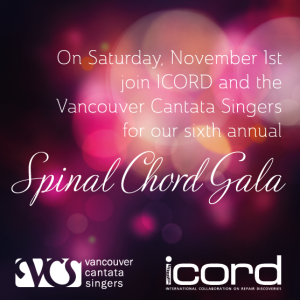 Tickets are now available for this year’s Spinal Chord Gala, coming up on Saturday November 1st. This is your chance to get dressed up, hear an award-winning choir in the spectacular atrium of the Blusson Spinal Cord Centre, enjoy fabulous hors d’oeuvres and decadent desserts, and bid on some interesting silent auction items, all in support of ICORD and the Vancouver Cantata Singers.
Tickets are now available for this year’s Spinal Chord Gala, coming up on Saturday November 1st. This is your chance to get dressed up, hear an award-winning choir in the spectacular atrium of the Blusson Spinal Cord Centre, enjoy fabulous hors d’oeuvres and decadent desserts, and bid on some interesting silent auction items, all in support of ICORD and the Vancouver Cantata Singers.
Buy your tickets before October 1st and you’ll automatically be entered to win a prize package including vintage rosé cushion cut Swarovski crystal earrings with clear pave stones from Jeweliette Jewellery and gift cards from Luxe Beauty Lounge and BierCraft Restaurant ($175 value). Tickets are available for purchase online and in person at the ICORD Admin Office.
We are delighted and grateful to welcome new and returning sponsors Lazy Gourmet, Life Studio, Sutton Place Hotel, Hawksworth Restaurant, Jeweliette Jewellery, Enotecca Wineries, Butter Studios, Luxe Beauty Lounge, Gusto Chocolates, BierCraft Resturant, The Cake Pop Shop, The Soirette, La Macaronette, and Sunflower Florist.
If you would like to sponsor the gala, we have some information for you here or you can contact us.
 Proprioception and other current research studies
Proprioception and other current research studies
Can you close your eyes and touch your nose? You are using your proprioceptive sense to do this. Proprioception is complex, and is affected by many factors, including conditions like SCI or stroke. Researchers in Dr. Tania Lam‘s lab are currently studying how lower limb proprioceptive sense impacts skilled walking. You may be able to participate if you had an incomplete SCI at least 9 months ago and are in stable medical condition, or you can be a control volunteer if you have no injuries interfering with your ability to walk.
This research involves testing with the Lokomat (to measure proprioceptive sense), goniometers (to measure joint angles), motion capture analysis (to measure your foot position relative to the obstacle), and lastly an eye tracker (to measure where you are looking during the task). In addition, SCI participants will do some walking and balance tests, and control group participants will do some walking, balance, and obstacle crossing tests.
Your participation in this research will help researchers understand how the sensory system contributes to the recovery of skilled walking ability. Although sensory function is often affected by SCI, we know surprisingly little about how this impacts mobility outcomes. The information from this study will help us to further advance rehabilitation strategies to promote functional mobility.
We have lots of other interesting studies going on at ICORD. Some of them take just a few minutes of your time, others require one or more visits to ICORD. By participating in a study, you are helping researchers learn about potential new treatments or rehabilitation strategies for SCI, and you might learn something interesting while you’re at it. Your expenses are generally covered, and sometimes there are other perks. These are just a few of the studies recruiting right now (click on the links for complete details including requirements for participation):
- Exoskeleton and COMBO design survey (complete a survey)
- WiinWalk (play some Nintendo Wii games or brain activity games)
- WheelSeeU (participate in peer-led wheelchair training programs or social groups)
- POWER Mobility Toolkit (complete questionnaires)
Self-defense class: a big hit!
Do you know what to do if someone grabs you, points a gun at you, or otherwise threatens your safety? A group of us found out when Hit & Run Self Defense gave two excellent classes at ICORD earlier this year. The classes were tailored for people of all sizes and physical ability, with specific wheelchair options. In the interactive sessions, participants were engaged in a variety of self-defense exercises, street-smart theory, and hands-on interactions!
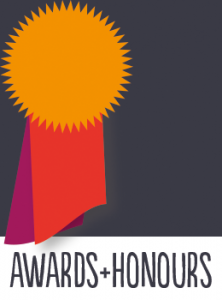 Spinal Chord Awards for Staff Excellence
Spinal Chord Awards for Staff Excellence
Congratulations to Yuan Jiang and Elena Okon, who won the Spinal Chord Awards for Staff Excellence for 2014. Supported with funds raised at the annual Spinal Chord gala, these awards celebrate the work done by ICORD staff. Staff members can be nominated for a particularly well-done task or project, or for overall excellence in the performance of their duties. Two awards, one for Service Excellence and one for Research Excellence, are presented annually.
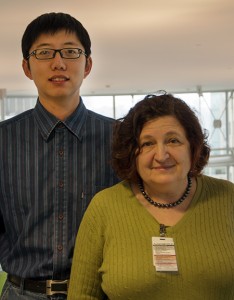
Congratulations to Yuan (L) and Elena (R), winners of the 2014 Spinal Chord Awards for Staff Excellence.
Dr. Elena Okon won the award for Research. “Elena is an incredible fountain of knowledge, possessing a diverse understanding of many fields of science,” said one of her colleagues in a nomination letter. “She is a wonderful resource in our lab, on whom we can always depend to impart knowledge and instruct. She loves to engage the student members of the lab in conversations of science and research, and this greatly enriches their learning experience. Her extensive science background also means she can provide our data interpretation with fresh perspectives and insights, linking together different areas of research and creating a richer scientific conversation.”
Yuan Jiang won the award for service. “Ever since he started with ICORD, he has been extremely hard-working, meticulous and organized,” Yuan’s manager said. “He is famous for having the best cryostat technique at ICORD, and finds innovative solutions to problems in both histology and data analysis. Everyone who works with him has been impressed with his dedication. He will stay and help to get a job done, regardless of the day or time. He has taken on many jobs and projects on his own time just because he sees a need.”
Meet a few of our stars
If you’ve ever been to a research conference, you’ll know that one of the great ways that participants–especially graduate students–share information is by presenting posters that describe their research projects. ICORD’s annual research meeting always includes a poster session to allow for this fruitful knowledge exchange, and thanks to some generous donors, we are able to provide awards for some of the best work. Poster awards can be used for travel to research conferences, specialized training, or research tools.
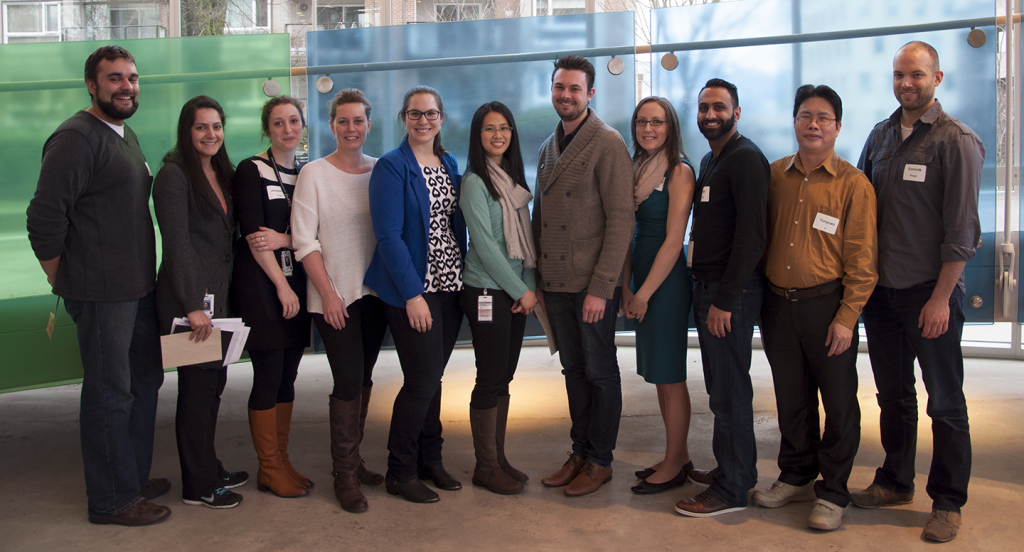
Winners of the 2014 poster competition (L-R): T. Bhatnagar, N. Manouchehri, J. Cragg, F. Streijger, J. Soicher, K. So, J. Squair, A. Chisholm, R. Malik, Y. Li, D. Zbogar
The Gordon Hiebert Award is for the best poster by an ICORD trainee at the Postdoctoral Fellow or Resident level. This award is named in memory of former ICORD trainee, Dr Gordon Hiebert. Gord came to ICORD in 1996 for his postdoctoral training, joining the labs of Drs. Wolfram Tetzlaff and John Steeves to broaden his knowledge base by studying the molecular mechanisms of spinal cord regeneration. In 2001, Gord left for Saskatoon and later Edmonton to combine his molecular and electrophysiological skills to better understand SCI-induced plasticity in spared motor systems. On May 26, 2004, SCI research lost a friend and colleague when Gord passed away at the age of 36 following a battle with cancer. Along with his significant scientific contributions, Gord will be remembered as a friend to all who knew him.
- 1st place: Dr. Amanda Chisholm – Amanda is a postdoctoral fellow working in Dr. Tania Lam’s laboratory. Her research project involves testing whether sensory stimulation combined with physical practice enhances walking ability in people with a SCI. This research is relevant to people with SCI because new robotic-based training designs offer a unique method to target features of walking that are important for everyday tasks (e.g. stairs and obstacles).
- 2nd place: Dr. Yunyuan Li – In Dr. Aziz Ghahary’s Laboratory, Yunyuan is studying how to generate pluripotent stem cells (one type of stem cell that can give rise to all cell types of whole body tissue) from adult blood cells by using a novel technique.
- [no 3rd place awarded for 2014]
The Aaron Moser Award goes to the best poster presented by an ICORD trainee at the Doctoral Student level. This award is named for Aaron Moser. In 1988, while playing hockey for the Nanaimo Clippers, Aaron was checked from behind into the boards and suffered a broken neck, severing his spinal cord and leaving him with no movement from the neck down. After his injury, his teammates and friends set up a trust fund to raise money for the equipment, supplies, renovations, and other expenses he would have during his rehabilitation. The Aaron Moser Spinal Cord Injury Foundation was started with the remaining funds. The sole purpose of this foundation is to raise money toward spinal cord research and, ultimately, to find a cure for paralysis.
- 1st place: Jacquelyn Cragg – Jac is a PhD student with Dr. Jaimie Borisoff (ICORD) and Dr. David Patrick (UBC School of Population and Public Health). Her research project focuses on the greater risk of cardiovascular disease among people with SCI. This risk may be a result of physical inactivity (as a result of the disability), but there may be other contributing factors as well.
- 2nd place: Tim Bhatnagar – In Dr. Thomas Oxland’s lab, Tim is studying how measured mechanical strain in the spinal cord, during acute SCI, correlates with the biological damage we see after injury. This research will provide a better understanding of how different spinal cord injury mechanisms can cause different patterns of SCI damage, something that clinicians have been looking to investigate for some time.
- 3rd place: Dominik Zbogar – In Dr. Janice Eng’s laboratory, Dominik is investigating the amount of physical activity that individuals with SCI experience when they are in rehabilitation at GF. Strong. Knowing the amount of physical activity experienced in and outside of therapy sessions is important for the development of interventions that will help to optimize rehabilitation and improve outcomes by enhancing motor learning and generating lasting neural modification.
In honour of the ongoing fundraising for ICORD done by the students at W.L. McLeod Elementary School in Vanderhoof, BC, the poster prize for Masters students is named the W.L. McLeod Trainee Award.
- 1st place: Jordan Squair – Jordan is an M.Sc. student in Dr. Mark Carpenter’s laboratory. His research project involves testing for small levels of muscle function in persons with SCI. This research is relevant to people with SCI because correctly detecting small levels of muscle function may improve our ability to specifically target rehabilitation.
- 2nd place: Jackie Soicher – Jackie works in Dr. Peter Cripton’s lab studying the feasibility of using pressure sensors to directly measure swelling in the spinal cord after injury.
- 3rd place: Raza Malik – In Dr. Tania Lam’s Laboratory, Raza is studying the feasibility and mechanism by which sensory tongue stimulation combined with balance and gait training can improve mobility in persons with incomplete SCI. This research is important because the tongue stimulator is a relatively inexpensive method of sensory stimulation.
The ICORD Staff Award is presented to the best poster by an ICORD staff member.
- 1st place: Neda Manouchehri – Neda is a research technician in Dr. Brian Kwon’s lab. She is involved in many different projects. One of her jobs is to process human cerebrospinal fluid samples to check for biomarker and antibody levels which might better predict injury severity.
- 2nd place: Dr. Femke Streijger – As a researcher working with Drs. Brian Kwon and Wolfram Tetzlaff, Femke has a great interest in understanding how dietary manipulations and nutritional interventions may provide neuroprotective benefits in neurological disorders such as spinal cord injury. A better understanding of the effects of dietary components might allow a rational design of diets for the purpose of manipulating cell functions and enhancing neurological outcomes following spinal cord injury.
- 3rd place (tie): Andrew Yung – Staff Award, Andrew works in Dr. Piotr Kozlowski’s laboratory, investigating MRI as a technique to noninvasively detect microscopic features of the injured spinal cord. This can be useful in predicting the long term effects of the injury, as well as to monitor the success of various SCI therapies over time.
- 3rd place (tie): Kitty So – Together with her colleagues in Dr. Brian Kwon’s laboratory, Kitty is studying how the pressure on–and blood flow to–the spinal cord changes after a spinal cord injury. This research is important because it could provide us with valuable information on what doctors can do for SCI patients immediately after their injury in order to alleviate pressure on the spinal cord and increase blood supply to the cord, thus limiting further damage, which could ultimately lead to less severe injuries and a better recovery outcome.
Take part in the Scotiabank Half Marathon and support SCI-BC
 Get read to roll, run, or walk! Bring your family and friends together on Sunday, June 22 and join SCI BC’s team, the Walk ‘n’ Rollers, in the Scotiabank Vancouver Half Marathon & 5K Group Charity Challenge at Stanley Park. This year, they’re one of three feature charities. With your support, SCI BC is hoping to raise $30,000 to help people living with spinal cord injury adjust, adapt, and thrive. Learn more about the event and sign-up for their team today or contact Gary at 604-326-1210. Can’t commit to the Charity Challenge? Why not sponsor one of this year’s Walk ‘n’ Rollers!
Get read to roll, run, or walk! Bring your family and friends together on Sunday, June 22 and join SCI BC’s team, the Walk ‘n’ Rollers, in the Scotiabank Vancouver Half Marathon & 5K Group Charity Challenge at Stanley Park. This year, they’re one of three feature charities. With your support, SCI BC is hoping to raise $30,000 to help people living with spinal cord injury adjust, adapt, and thrive. Learn more about the event and sign-up for their team today or contact Gary at 604-326-1210. Can’t commit to the Charity Challenge? Why not sponsor one of this year’s Walk ‘n’ Rollers!
New website provided for clinicians to calculate the motor and sensory impairment and severity of SCI
The International Standards for Neurological Classification of Spinal Cord Injury (ISNCSCI) is an examination used to determine the motor and sensory impairment and severity of an SCI. The American Spinal Injury Association (ASIA) International Standards Committee is responsible for reviewing and revising the ISNCSCI to reflect current evidence.
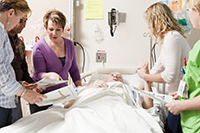 In partnership with the International Spinal Cord Society (ISCoS) and a group of international experts, the Rick Hansen Institute has developed an algorithm which utilizes raw test scores determined by performing the exam (including not testable values) to electronically score and classify a spinal cord injury using the ISNCSCI (revised 2011) scoring rules. The first complete and fully validated version of the ISNCSCI Algorithm (Version 1.0) was officially launched on May 13, after undergoing rigorous beta site testing. Use of the beta site was quite popular, with over 5,500 return users from 108 countries around the world. The algorithm will also be available in an open source format free of charge to support groups who want to integrate it into their own research databases and electronic medical records. Click to learn more.
In partnership with the International Spinal Cord Society (ISCoS) and a group of international experts, the Rick Hansen Institute has developed an algorithm which utilizes raw test scores determined by performing the exam (including not testable values) to electronically score and classify a spinal cord injury using the ISNCSCI (revised 2011) scoring rules. The first complete and fully validated version of the ISNCSCI Algorithm (Version 1.0) was officially launched on May 13, after undergoing rigorous beta site testing. Use of the beta site was quite popular, with over 5,500 return users from 108 countries around the world. The algorithm will also be available in an open source format free of charge to support groups who want to integrate it into their own research databases and electronic medical records. Click to learn more.
Rick Hansen Institute Postdoctoral Fellowship
The Rick Hansen Institute is pleased to share a funding opportunity for a postdoctoral fellowship through the University of Ottawa’s Faculty of Medicine program. In partnership with the university, the Rick Hansen Institute Postdoctoral Fellowship intends  to support a postdoctoral fellow whose primary focus is on knowledge transfer and/or implementation sciences related to spinal cord injury. The recipient will also have the opportunity to participate in various knowledge transfer-related projects currently funded by RHI and its SCI partners. Click here for more details and how to apply. All interested parties are encouraged to apply for this opportunity. Deadline to submit an application is June 30, 2014.
to support a postdoctoral fellow whose primary focus is on knowledge transfer and/or implementation sciences related to spinal cord injury. The recipient will also have the opportunity to participate in various knowledge transfer-related projects currently funded by RHI and its SCI partners. Click here for more details and how to apply. All interested parties are encouraged to apply for this opportunity. Deadline to submit an application is June 30, 2014.
Wondering about the image we used for this issue’s cover?
It’s a micrograph made by researchers in the Tetzlaff Lab, of Schwann cells (shown in green–these are cells that help to insulate axons in our peripheral nervous system) that have been successfully transplanted into an injured rodent spinal cord. Host spinal cord axons (shown in red–the portion of neurons that carry signals to different parts of the body) are seen growing across these transplanted cells that bridge the injury site. Axons that are being actively wrapped (isolated, or myelinated) by the transplanted green cells appear yellow.
Please take our quick survey!
We are interested in your thoughts on our newsletter and other community-focused communications and events.


